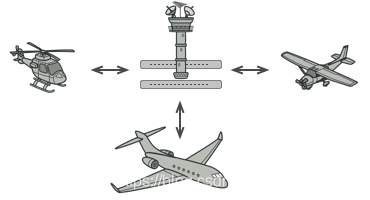1、中介者模式:
中介者模式是一种行为设计模式, 能让你减少对象之间混乱无序的依赖关系。 该模式会限制对象之间的直接交互, 迫使它们通过一个中介者对象进行合作。
真实世界例子: 飞行器驾驶员之间不会通过相互沟通来决定下一架降落的飞机。 所有沟通都通过控制塔台进行。

2.1、中介者模式结构:
- 组件(Component):各种包含业务逻辑的类。每个组件都有一个指向中介者的引用,该引用被声明为中介者接口类型。组件不知道中介者实际所属的类,因此你可通过将其连接到不同的中介者以使其能在其他程序中复用。
- 中介者(Mediator):接口声明了与组件交流的方法, 但通常仅包括一个通知方法。 组件可将任意上下文 (包括自己的对象) 作为该方法的参数, 只有这样接收组件和发送者类之间才不会耦合。
- 具体中介者(Concrete Mediator):封装了多种组件间的关系。具体中介者通常会保存所有组件的引用并对其进行管理,甚至有时会对其生命周期进行管理。
组件间具体交流方式: 组件并不知道其他组件的情况。如果组件内发生了重要事件,它只能通知中介者。中介者收到通知后能轻易地确定发送者,这或许已足以判断接下来需要触发的组件了。对于组件来说,中介者看上去完全就是一个黑箱。发送者不知道最终会由谁来处理自己的请求,接收者也不知道最初是谁发出了请求。
2.2、中介者模式与其他模式区别:
中介者模式优缺点: 一段时间后,中介者可能会演化成为上帝对象。
个人理解: 可以用于组件之间发消息。想象成树状结构,避免子节点间直接交互,而是通过父节点来交互。
外观模式与中介者模式的区别:
外观为子系统中的所有对象定义了一个简单接口,但是它不提供任何新功能。子系统本身不会意识到外观的存在。子系统中的对象可以直接进行交流。 中介者将系统中组件的沟通行为中心化。 各组件只知道中介者对象, 无法直接相互交流。
观察者模式与中介者模式的区别:
中介者的主要目标是消除一系列系统组件之间的相互依赖。这些组件将依赖于同一个中介者对象。观察者的目标是在对象之间建立动态的单向连接,使得部分对象可作为其他对象的附属发挥作用。
2.3、代码例子:
#include <iostream>
#include <string>
/**
* The Mediator interface declares a method used by components to notify the
* mediator about various events. The Mediator may react to these events and
* pass the execution to other components.
*/
class BaseComponent;
class Mediator {
public:
virtual void Notify(BaseComponent *sender, std::string event) const = 0;
};
/**
* The Base Component provides the basic functionality of storing a mediator's
* instance inside component objects.
*/
class BaseComponent {
protected:
Mediator *mediator_;
public:
BaseComponent(Mediator *mediator = nullptr) : mediator_(mediator) {
}
void set_mediator(Mediator *mediator) {
this->mediator_ = mediator;
}
};
/**
* Concrete Components implement various functionality. They don't depend on
* other components. They also don't depend on any concrete mediator classes.
*/
class Component1 : public BaseComponent {
public:
void DoA() {
std::cout << "Component 1 does A.\n";
this->mediator_->Notify(this, "A");
}
void DoB() {
std::cout << "Component 1 does B.\n";
this->mediator_->Notify(this, "B");
}
};
class Component2 : public BaseComponent {
public:
void DoC() {
std::cout << "Component 2 does C.\n";
this->mediator_->Notify(this, "C");
}
void DoD() {
std::cout << "Component 2 does D.\n";
this->mediator_->Notify(this, "D");
}
};
/**
* Concrete Mediators implement cooperative behavior by coordinating several
* components.
*/
class ConcreteMediator : public Mediator {
private:
Component1 *component1_;
Component2 *component2_;
public:
ConcreteMediator(Component1 *c1, Component2 *c2) : component1_(c1), component2_(c2) {
this->component1_->set_mediator(this);
this->component2_->set_mediator(this);
}
void Notify(BaseComponent *sender, std::string event) const override {
if (event == "A") {
std::cout << "Mediator reacts on A and triggers following operations:\n";
this->component2_->DoC();
}
if (event == "D") {
std::cout << "Mediator reacts on D and triggers following operations:\n";
this->component1_->DoB();
this->component2_->DoC();
}
}
};
/**
* The client code.
*/
void ClientCode() {
Component1 *c1 = new Component1;
Component2 *c2 = new Component2;
ConcreteMediator *mediator = new ConcreteMediator(c1, c2);
std::cout << "Client triggers operation A.\n";
c1->DoA();
std::cout << "\n";
std::cout << "Client triggers operation D.\n";
c2->DoD();
delete c1;
delete c2;
delete mediator;
}
int main() {
ClientCode();
return 0;
}
参考资料:设计模式->行为模式:中介者模式





















 578
578











 被折叠的 条评论
为什么被折叠?
被折叠的 条评论
为什么被折叠?








